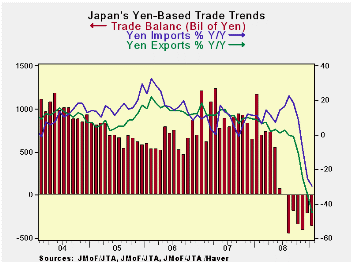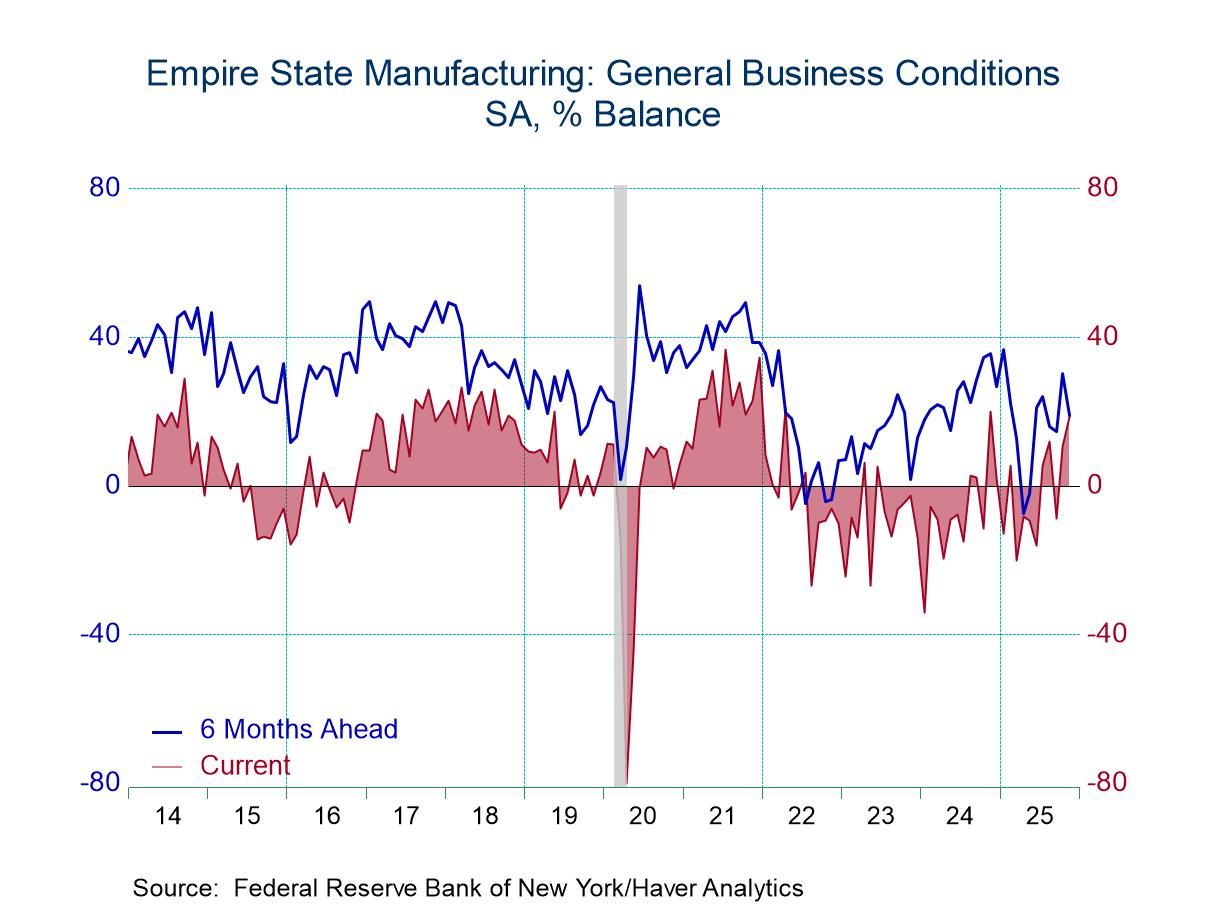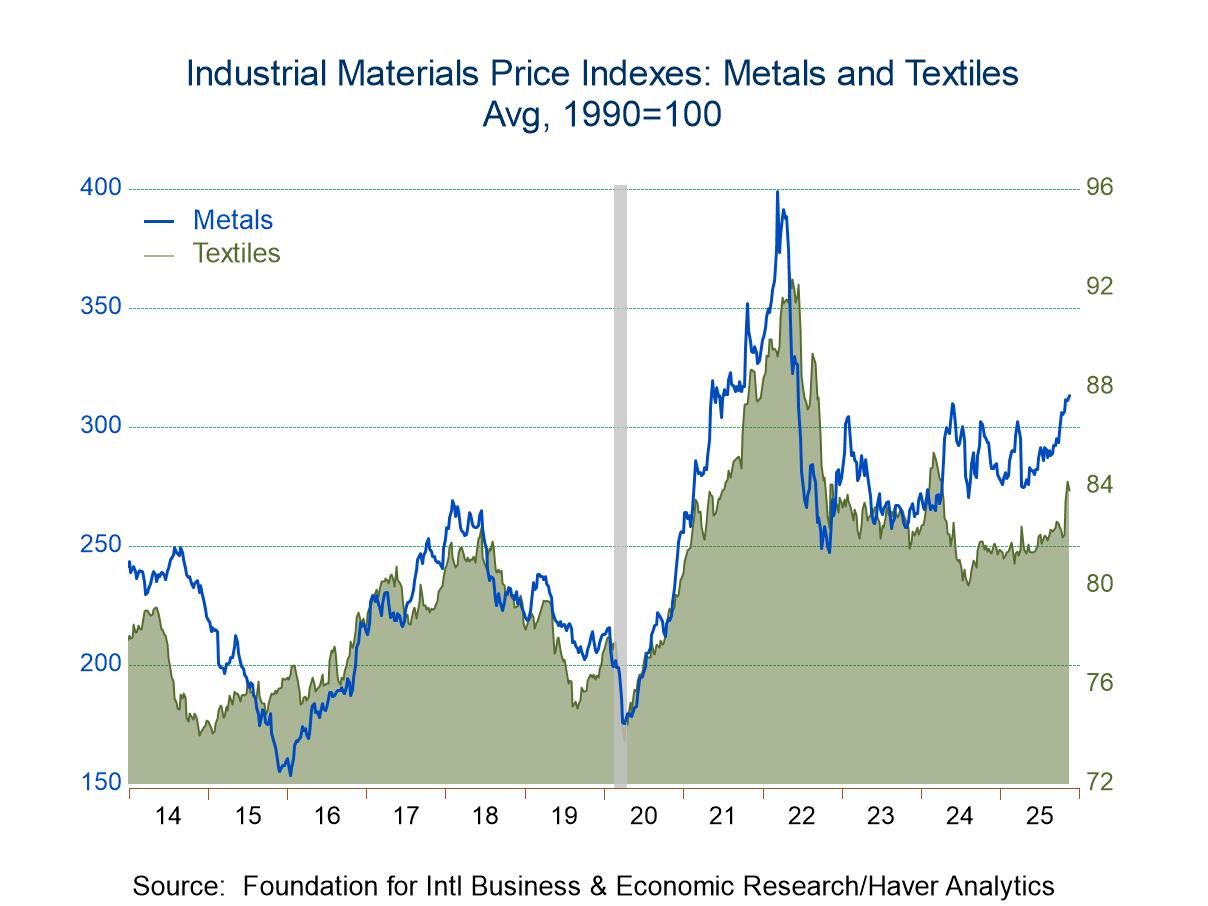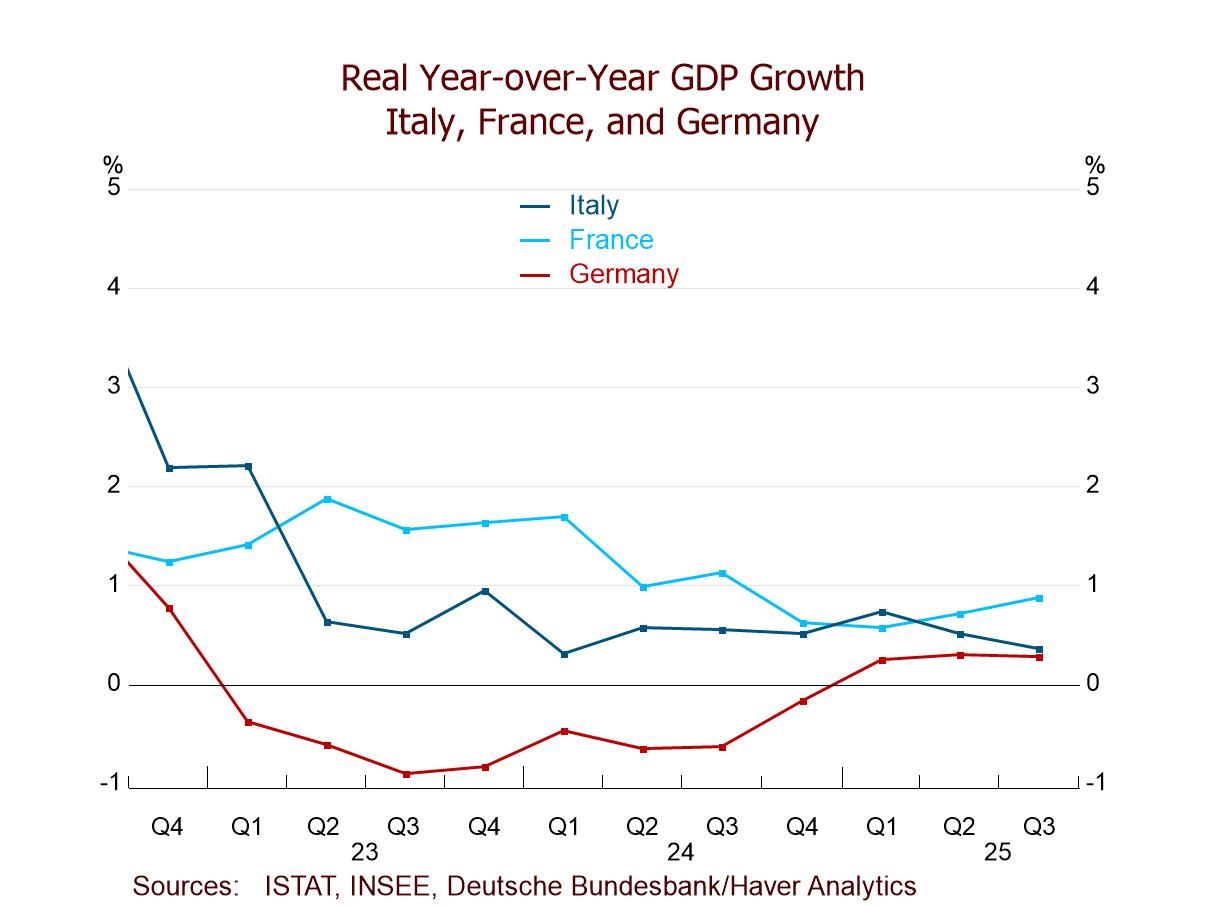 Global| Feb 25 2009
Global| Feb 25 2009Yen-Based Japan Exports Are Cut Nearly In Half
Summary
In a stunning blow to a reeling economy Japan reports that its exports are lower in January compared to one year ago by 45% - nearly halving of the flow. There are several components to this drop. One is the yen that has risen; that [...]

In a stunning blow to a reeling economy Japan reports that its
exports are lower in January compared to one year ago by 45% - nearly
halving of the flow. There are several components to this drop. One is
the yen that has risen; that will translate foreign currency-based
Japan exports into a smaller value in terms of yen. The yen rose to
90.12/$ in January compared to its level of 101.91/$ a year ago, a yen
rise of 16%. Another aspect of the drop in value is that yen-based
export prices have fallen Year over year. Japan export prices fell by
13.5% Year over year. These two factors make up a good deal of the 45%
drop in the yen value of Japan’s exports. But not all of Japan’s
exports are in dollar terms. Japan’s largest trade partner in fact is
China; its second largest partner is the US. Moreover, the drop in the
current value of yen trade flows is not simply an ‘index number’
problem. It does reflect real stress that flows back to Japan when
export dollar sales buy fewer yen, especially if Japan’s costs are
expressed in yen- as most surely are despite outsourcing.
Japan’s imports are down by nearly 30% Year-over-year, another
significant number. The rise in the yen plays a role there by first
taking a fixed import bill expressed in foreign currency and making it
smaller when translated into a stronger yen, just as for exports. But
eventually the stronger yen and weaker FX value of competing currencies
should lead to an increase in Japan’s import volumes and cause yen
VALUE flows to rise or at least to mitigate their drop (depending on
the size of the import price elasticities). Let’s look at this concept
of ‘elasticity:’ If Japan import price elasticities are less than
‘minus one’ Japan’s import values will eventually rise further as Japan
buys more of the cheaper import and that offsets the fact that each
import is worth fewer yen by increasing the volume of its purchases.
That is what the concept of elasticity measures. A price elasticity of
less than ‘minus one’ means that a one percent drop in yen prices (say
forced by a yen appreciation) will lead to more than a one percent
increase in the volume of goods imported. Yen import prices are falling
already (mostly lower oil prices). But the progression of events that
lead to a boost in import volumes takes time. Plus don’t hold your
breath waiting for this impact since Japan’s own recession is
contracting imports, a factor that will swamp and elasticity effect
from prices. For the moment, yen-based import prices are down by nearly
25% Yr/Yr accentuating any VOLUME drop in Japan’s imports on observed
import VALUE. Of course, to the extent that Japan invoices its imports
in yen the result of the yen’s rise would me blunted, since a yen
import is a yen import regardless of the dollar, euro or yuan exchange
rate.
On balance these trade flows for Japan paint a very distressed
picture of Japan’s economy. Japan has joined Germany and others in
being a voice in favor of maintaining ‘free trade.’ Just today the WTO
has issued another call for nations to uphold their free trade
agreements. The ‘buy America’ clause in the US stimulus bill is one
development that is cited again and again in these sorts of
communiqués. The US insists that its provision is fully consistent with
its free trade agreements.
We can see that with the world economy shutting down, like
some out of control Windows command that is turning off your computer
while you are trying to work, that chaos is being spread. Export
dependent nations are being crushed by the global economies since
manufactured goods exports have high relatively high income
elasticities. That means when times are good and global incomes are
growing exports shoot ahead strongly but it also means that export
volumes contract sharply in a downturn. Japan is being battered in part
by the impact of US auto sales dropping from over 15mu to just about
10mu. There is nothing anticompetitive about that: it’s just recession.
That is a drop of 33% and it will cause the Yr/Yr drop in yen exports
to be registered at about 46% if Japan holds its share in this
contracting market. Of course cutting back on shipments to the US to
trim inventories plus taking lower prices into account could further
exaggerate the flow’s ultimate decline. In the event, Japan’s exports
of autos in yen terms to the world have fallen by 66% since January of
one year ago.
| Japan Trade Trends | |||||||
|---|---|---|---|---|---|---|---|
| in period level of % ch | Average in period/or % change | ||||||
| All data yen basis | Jan-09 | Dec-08 | Nov-08 | 3Mprev | 6Mprv | 12-Mprv | 12 mo Ago |
| Balance on Goods | #N/A | (1,341) | (3,343) | (1,167) | (70) | 3,271 | 10,356 |
| % m/m | % saar | ||||||
| X Goods % | -10.4% | -11.6% | -13.4% | -83.5% | -63.5% | -44.9% | 8.8% |
| Motor Vehicles | -39.0% | -18.1% | -20.6% | -98.2% | -89.1% | -66.1% | 12.7% |
| M Goods %, | -6.9% | -14.2% | -11.7% | -79.5% | -57.1% | -29.6% | 11.3% |
| Motor Vehicles | -24.4% | 7.4% | 6.2% | -74.1% | -61.1% | -31.5% | 4.3% |
| Prices In %, saar | 3M | 6M | 12-M | 12 mo Ago | |||
| PX | 0.1% | -4.4% | -3.7% | -46.8% | -29.0% | -13.5% | -5.7% |
| PM | -4.2% | -11.4% | -10.3% | -77.8% | -57.0% | -24.6% | 7.4% |
| Memo: Yen/$, AVG, Level | 90.12 | 91.28 | 96.97 | 92.79 | 99.05 | 101.91 | 116.72 |
| Memo Yen Percent ('-' is a fall) | 1.3% | 5.9% | 3.0% | 48.9% | 28.9% | 16.4% | 10.5% |
Robert Brusca
AuthorMore in Author Profile »Robert A. Brusca is Chief Economist of Fact and Opinion Economics, a consulting firm he founded in Manhattan. He has been an economist on Wall Street for over 25 years. He has visited central banking and large institutional clients in over 30 countries in his career as an economist. Mr. Brusca was a Divisional Research Chief at the Federal Reserve Bank of NY (Chief of the International Financial markets Division), a Fed Watcher at Irving Trust and Chief Economist at Nikko Securities International. He is widely quoted and appears in various media. Mr. Brusca holds an MA and Ph.D. in economics from Michigan State University and a BA in Economics from the University of Michigan. His research pursues his strong interests in non aligned policy economics as well as international economics. FAO Economics’ research targets investors to assist them in making better investment decisions in stocks, bonds and in a variety of international assets. The company does not manage money and has no conflicts in giving economic advice.






